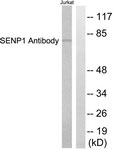SENP1 Antibody (aa1-50)
Rabbit Polyclonal Antibody
- SPECIFICATION
- CITATIONS
- PROTOCOLS
- BACKGROUND

Application
| WB, IHC-P, E |
|---|---|
| Primary Accession | Q9P0U3 |
| Reactivity | Human, Mouse |
| Host | Rabbit |
| Clonality | Polyclonal |
| Calculated MW | 73kDa |
| Dilution | ELISA (1:10000), IHC-P (10 µg/ml), WB (1:500-1:1000) |
| Gene ID | 29843 |
|---|---|
| Other Names | Sentrin-specific protease 1, 3.4.22.68, Sentrin/SUMO-specific protease SENP1, SENP1 |
| Target/Specificity | SENP1 Antibody detects endogenous levels of total SENP1 protein. |
| Reconstitution & Storage | Store at -20°C for up to one year. |
| Precautions | SENP1 Antibody (aa1-50) is for research use only and not for use in diagnostic or therapeutic procedures. |
| Name | SENP1 |
|---|---|
| Function | Protease that catalyzes two essential functions in the SUMO pathway (PubMed:10652325, PubMed:15199155, PubMed:16253240, PubMed:16553580, PubMed:21829689, PubMed:21965678, PubMed:23160374, PubMed:24943844, PubMed:25406032, PubMed:29506078). The first is the hydrolysis of an alpha-linked peptide bond at the C-terminal end of the small ubiquitin-like modifier (SUMO) propeptides, SUMO1, SUMO2 and SUMO3 leading to the mature form of the proteins. The second is the deconjugation of SUMO1, SUMO2 and SUMO3 from targeted proteins, by cleaving an epsilon-linked peptide bond between the C-terminal glycine of the mature SUMO and the lysine epsilon-amino group of the target protein. Deconjugates SUMO1 from HIPK2 (PubMed:16253240). Deconjugates SUMO1 from HDAC1 and BHLHE40/DEC1, which decreases its transcriptional repression activity (PubMed:21829689). Deconjugates SUMO1 from CLOCK, which decreases its transcriptional activation activity (PubMed:23160374). Deconjugates SUMO2 from MTA1 (PubMed:21965678). Deconjugates SUMO1 from METTL3 (PubMed:29506078). Desumoylates CCAR2 which decreases its interaction with SIRT1 (PubMed:25406032). Deconjugates SUMO1 from GPS2 (PubMed:24943844). |
| Cellular Location | Nucleus. Cytoplasm. Note=Shuttles between cytoplasm and nucleus |
| Tissue Location | Highly expressed in testis. Expressed at lower levels in thymus, pancreas, spleen, liver, ovary and small intestine |
| Volume | 50 µl |

Thousands of laboratories across the world have published research that depended on the performance of antibodies from Abcepta to advance their research. Check out links to articles that cite our products in major peer-reviewed journals, organized by research category.
info@abcepta.com, and receive a free "I Love Antibodies" mug.
Provided below are standard protocols that you may find useful for product applications.
Background
Protease that catalyzes two essential functions in the SUMO pathway: processing of full-length SUMO1, SUMO2 and SUMO3 to their mature forms and deconjugation of SUMO1, SUMO2 and SUMO3 from targeted proteins. Deconjugates SUMO1 from HIPK2. Deconjugates SUMO1 from HDAC1 and BHLHE40/DEC1, which decreases its transcriptional repression activity. Deconjugates SUMO1 from CLOCK, which decreases its transcriptional activation activity. Deconjugates SUMO2 from MTA1.
References
Gong L.,et al.J. Biol. Chem. 275:3355-3359(2000).
Ota T.,et al.Nat. Genet. 36:40-45(2004).
Scherer S.E.,et al.Nature 440:346-351(2006).
Bailey D.,et al.J. Biol. Chem. 279:692-703(2004).
Cheng J.,et al.Mol. Cell. Biol. 24:6021-6028(2004).
If you have used an Abcepta product and would like to share how it has performed, please click on the "Submit Review" button and provide the requested information. Our staff will examine and post your review and contact you if needed.
If you have any additional inquiries please email technical services at tech@abcepta.com.













 Foundational characteristics of cancer include proliferation, angiogenesis, migration, evasion of apoptosis, and cellular immortality. Find key markers for these cellular processes and antibodies to detect them.
Foundational characteristics of cancer include proliferation, angiogenesis, migration, evasion of apoptosis, and cellular immortality. Find key markers for these cellular processes and antibodies to detect them. The SUMOplot™ Analysis Program predicts and scores sumoylation sites in your protein. SUMOylation is a post-translational modification involved in various cellular processes, such as nuclear-cytosolic transport, transcriptional regulation, apoptosis, protein stability, response to stress, and progression through the cell cycle.
The SUMOplot™ Analysis Program predicts and scores sumoylation sites in your protein. SUMOylation is a post-translational modification involved in various cellular processes, such as nuclear-cytosolic transport, transcriptional regulation, apoptosis, protein stability, response to stress, and progression through the cell cycle. The Autophagy Receptor Motif Plotter predicts and scores autophagy receptor binding sites in your protein. Identifying proteins connected to this pathway is critical to understanding the role of autophagy in physiological as well as pathological processes such as development, differentiation, neurodegenerative diseases, stress, infection, and cancer.
The Autophagy Receptor Motif Plotter predicts and scores autophagy receptor binding sites in your protein. Identifying proteins connected to this pathway is critical to understanding the role of autophagy in physiological as well as pathological processes such as development, differentiation, neurodegenerative diseases, stress, infection, and cancer.


